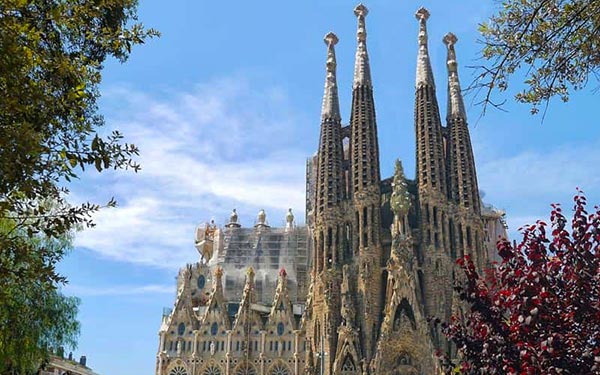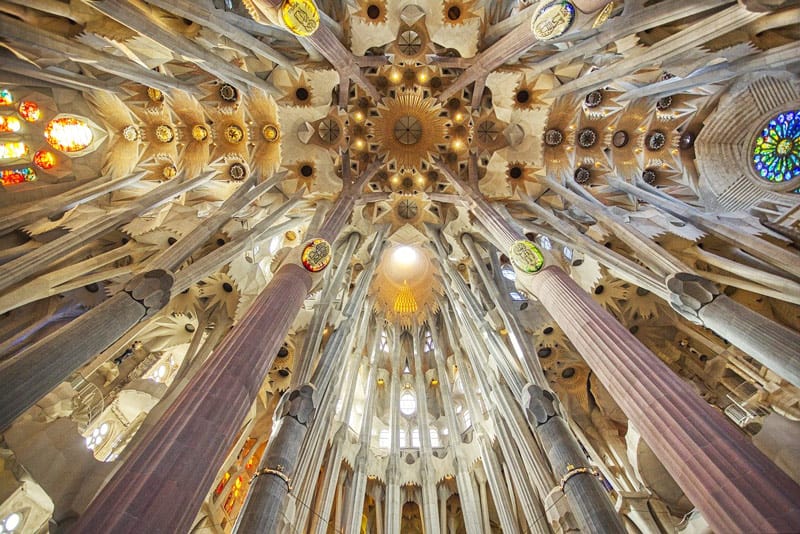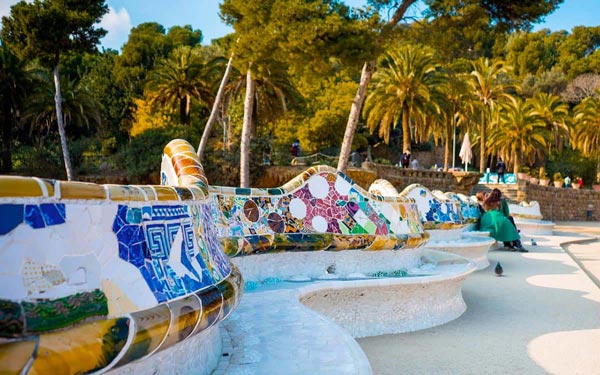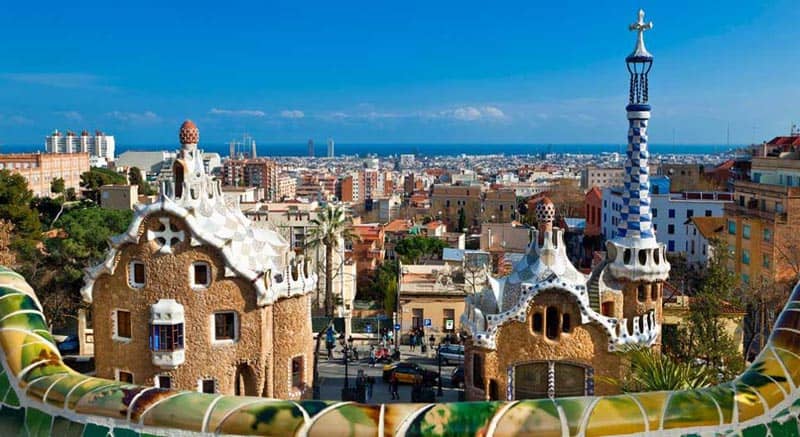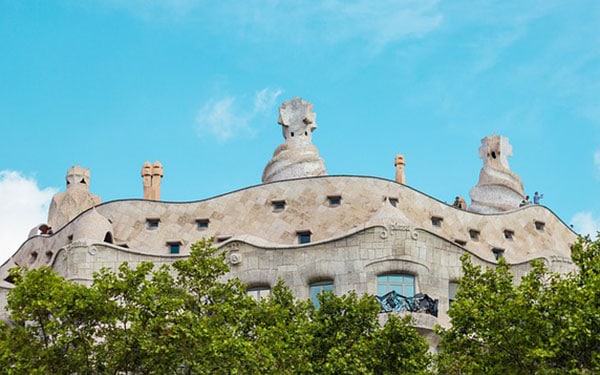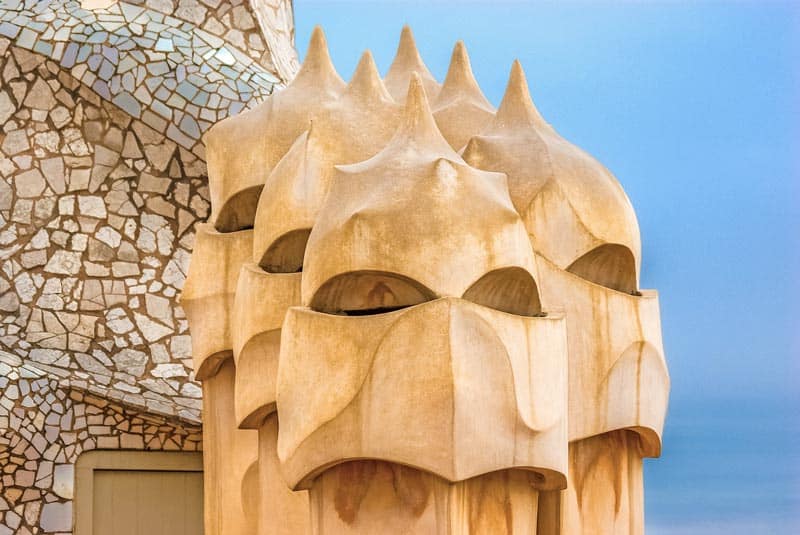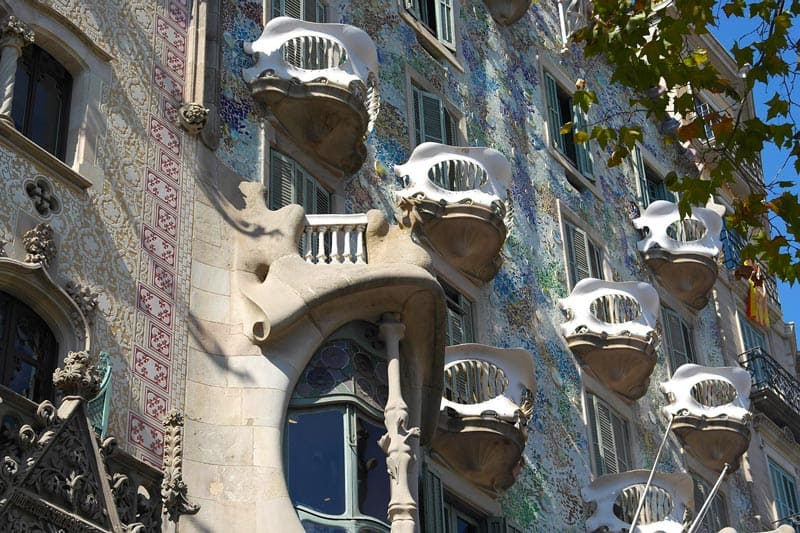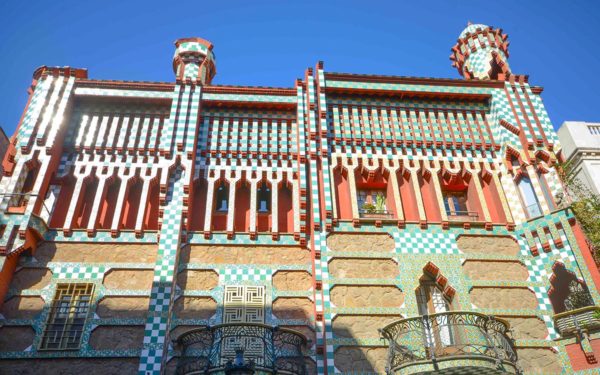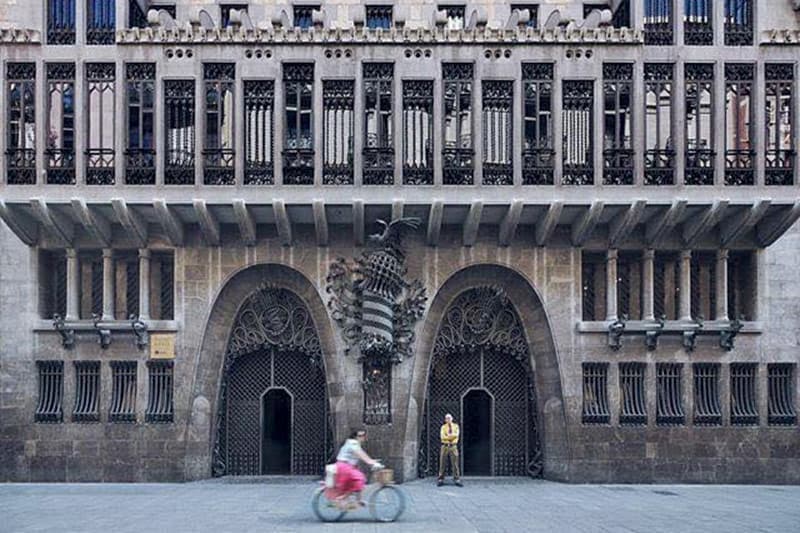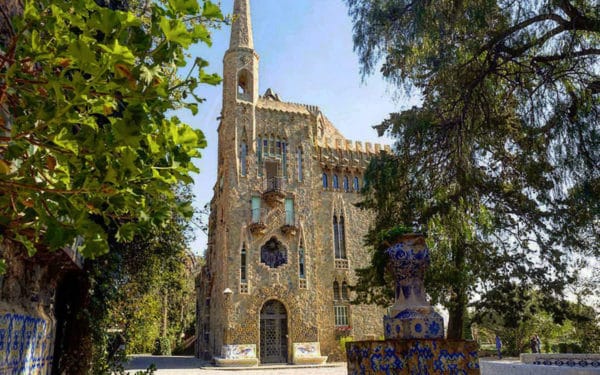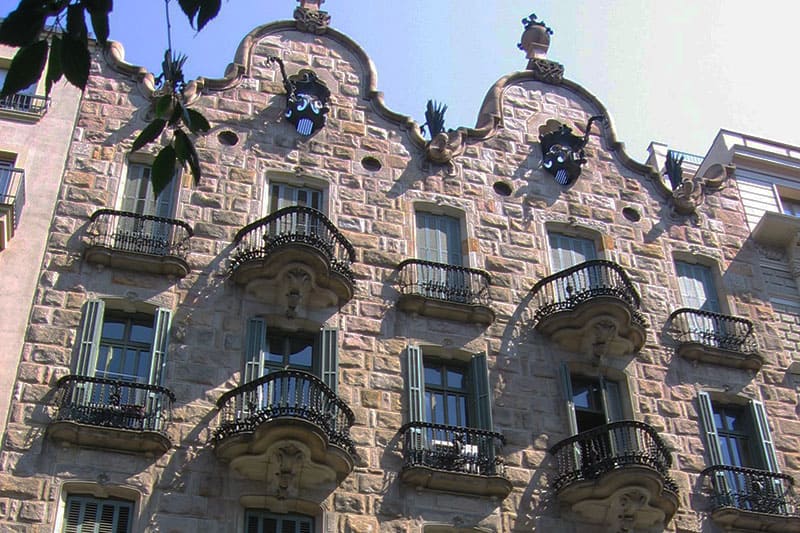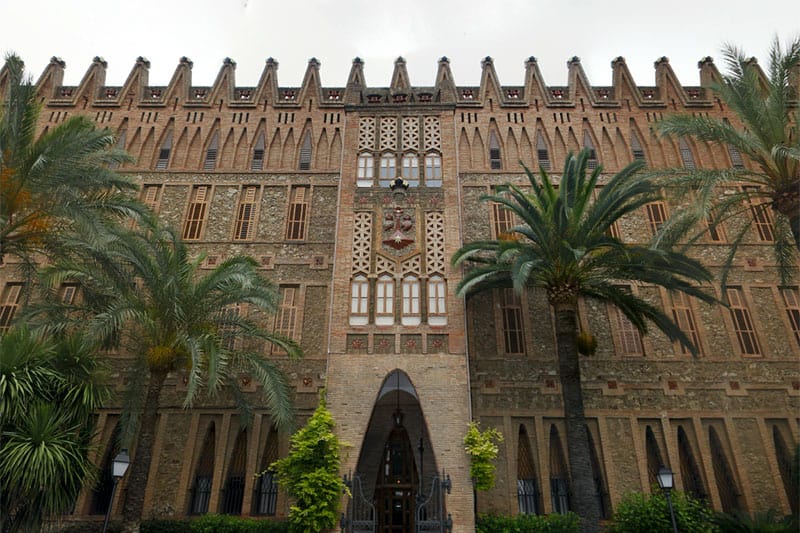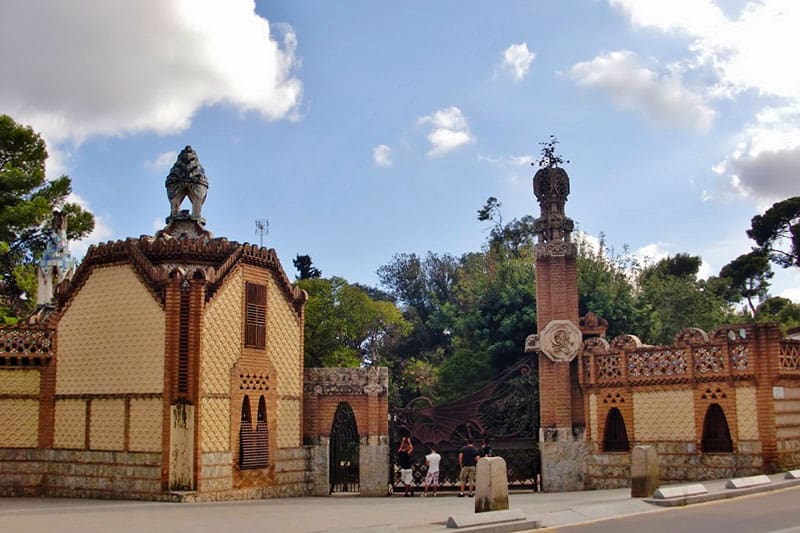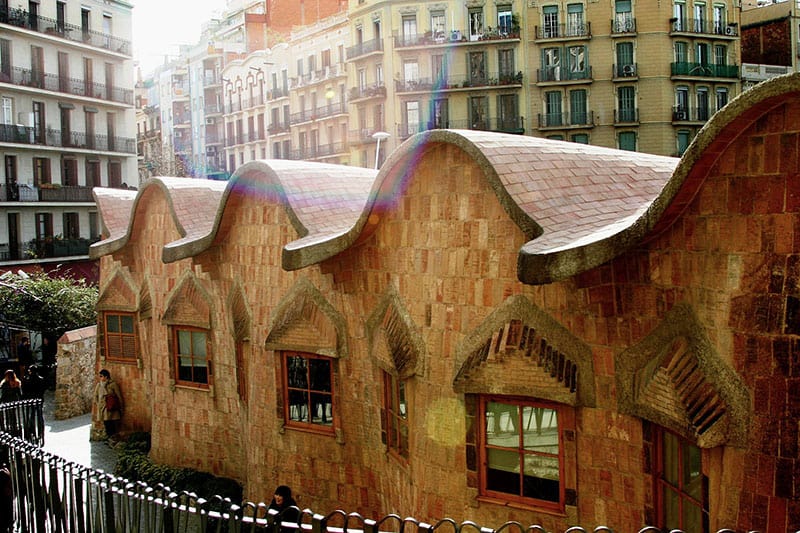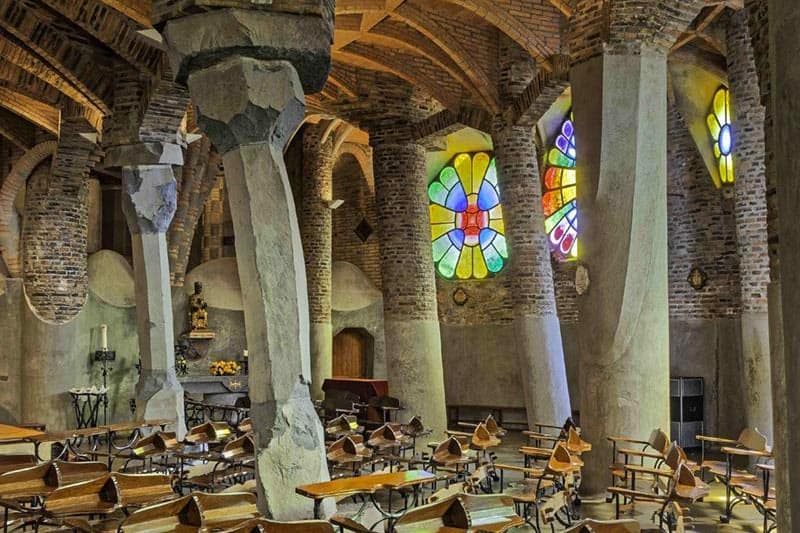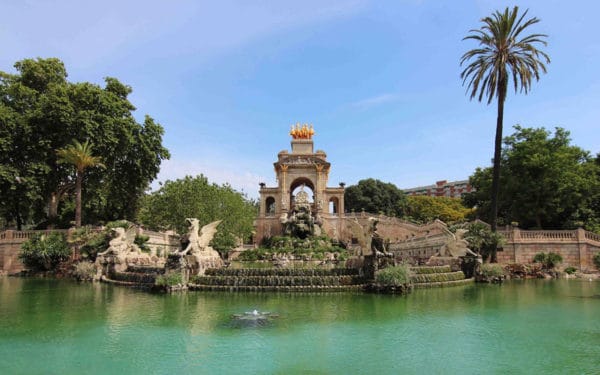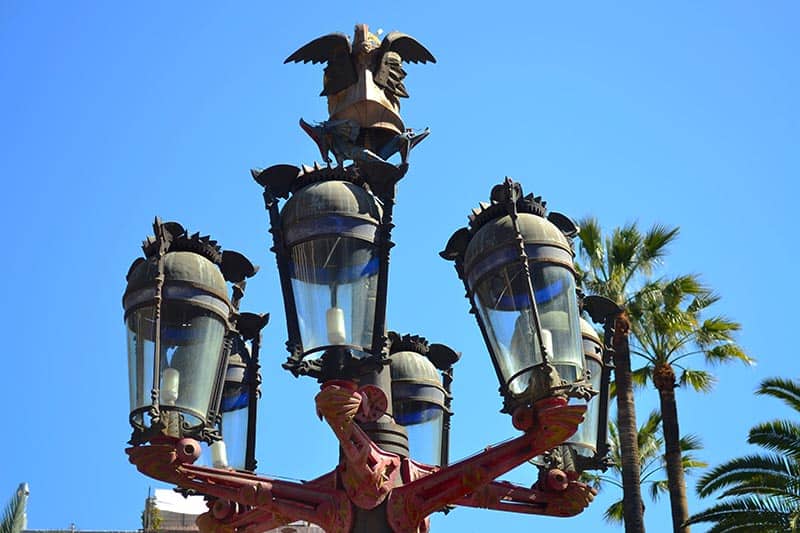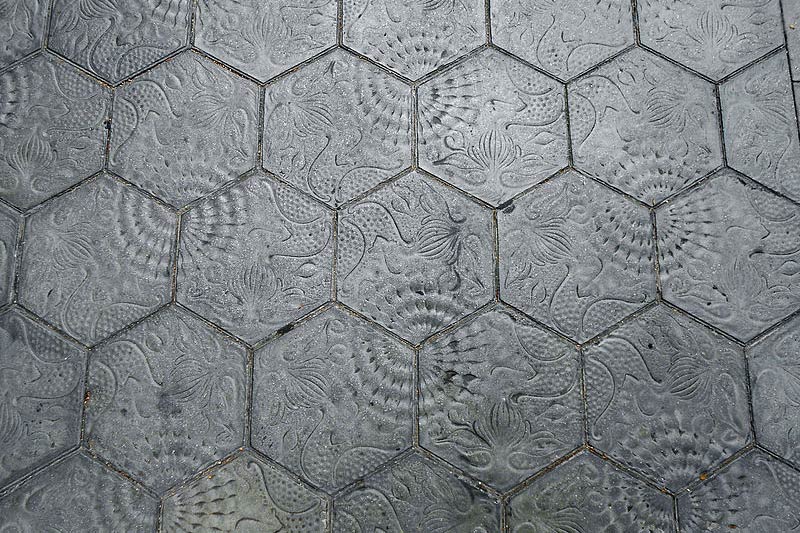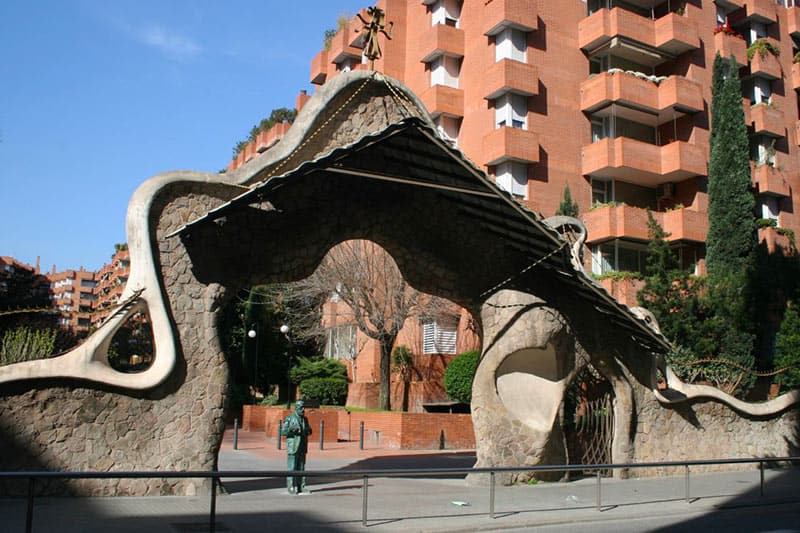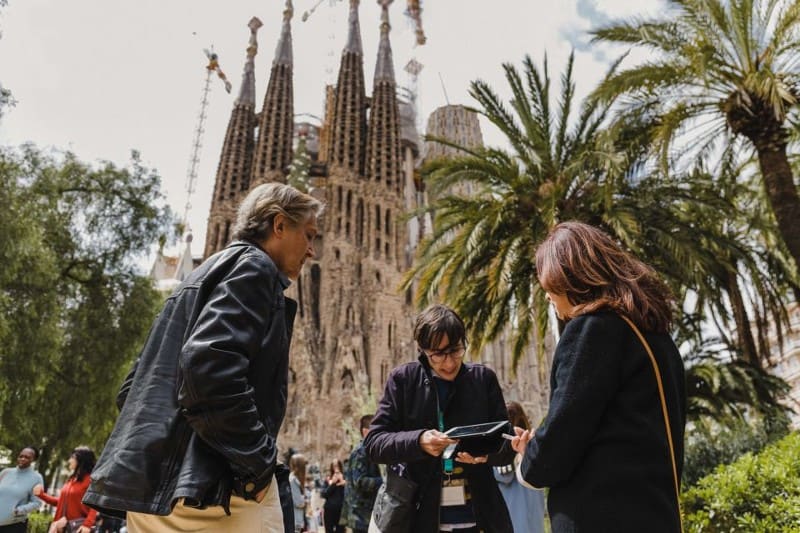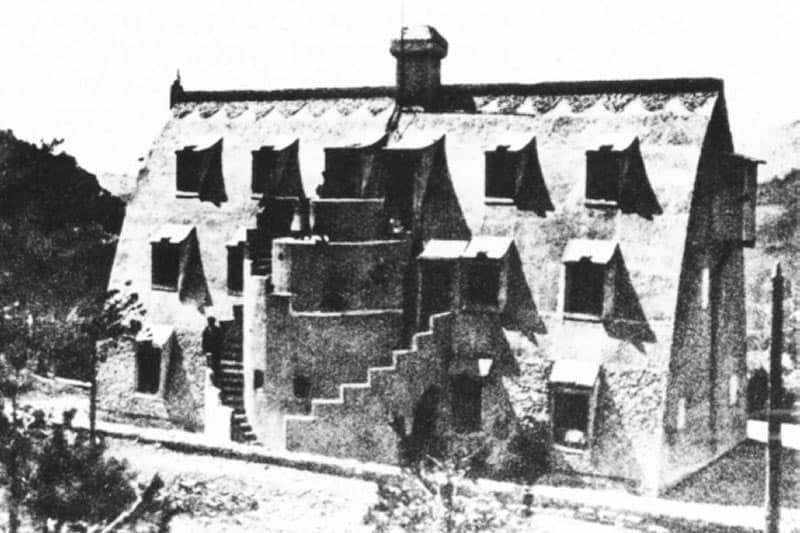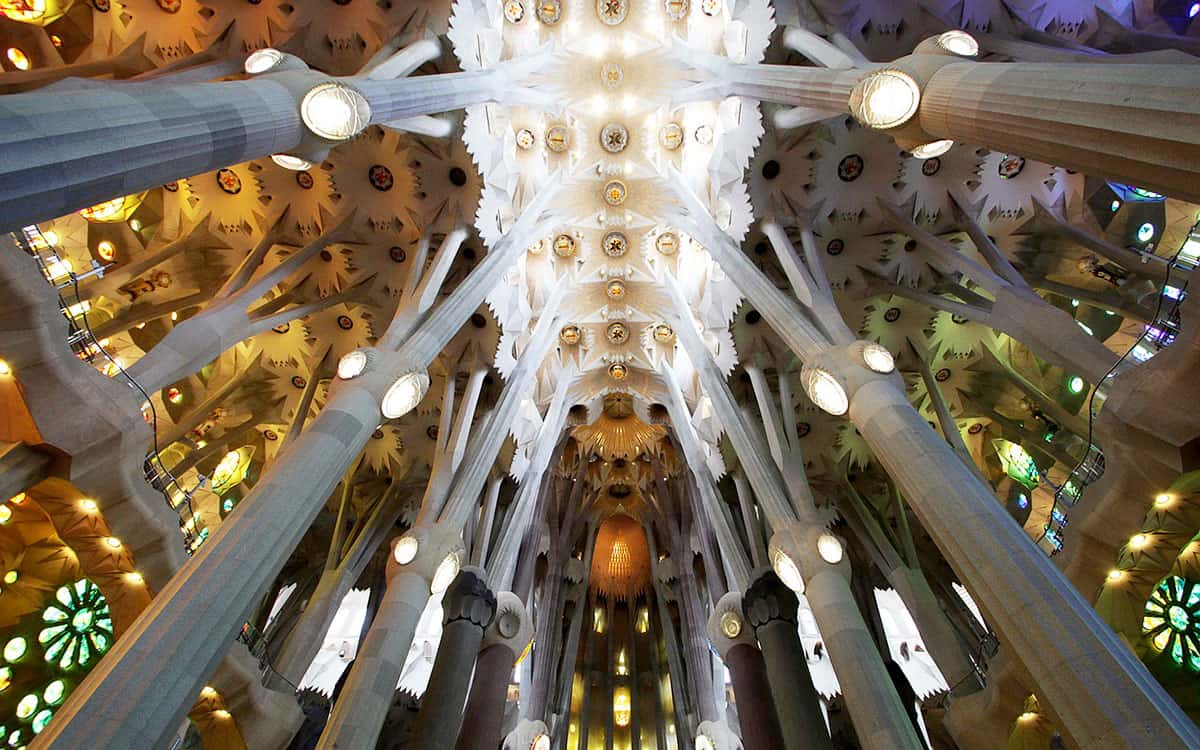
Gaudi
Antoni Gaudi the Great
Exploring the legacy of Gaudi in Barcelona
By Duncan Rhodes
No trip to the Catalan capital is complete without paying homage to the city’s star man! We look at the fascinating life of Gaudi, and review ALL 12 of his Barcelona buildings, including which you simply must visit. For each sight, we recommend the best place to buy tickets, as well as recommended guided tours and tourist passes.
This article was last updated in April 2024.
Rarely has a man become so synonymous with a city as Antoni Gaudi has with Barcelona. His incredibly expressive and individual style of architecture, part Modernisme (the regional Catalan take on art nouveau), part neo-Gothic and drawing on aspects of cubism and surrealism, has come to define the city’s aesthetic.
Rarely has a man become so synonymous with a city as Antoni Gaudi has with Barcelona…
It is intensely human, full of the imagery of nature and religion, and defiantly original – an apt reflection of the Catalan soul.
Read on for a comprehensive list of ALL of Gaudi’s buildings and architecture in Barcelona, museums featuring his works, plus selected guided tours.
But let’s start with his biography…
Biography of Gaudi’s Early Life
The 20th century’s most famous architect was born in Reus (or just outside, depending on what account you believe) in the Tarragona province of Catalonia, 80km south of Barcelona. After enduring a childhood troubled by rheumatism, the son of two coppersmiths travelled to the Catalan capital to enrol as an student at the Escola Tecnica Superior d’Arquitectura, where he duly studied from 1873 to 1877.
“Who knows if we have given this diploma to a nut or to a genius? Time will tell.”
Even then his professors did not quite know what to make of his work, and when he was awarded the title of architect in 1878, Elies Rogent, the director of the school, declared: “Who knows if we have given this diploma to a nut or to a genius? Time will tell.”
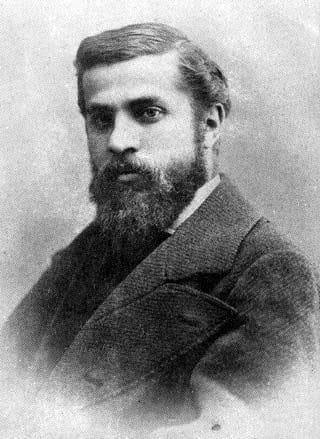
Did You Know…?
…that despite being universally admired in the 21st Century, Antoni Gaudi didn’t always enjoy such widespread praise. Amongst his detractors were George Orwell, who described La Sagrada Familia as “one of the most hideous buildings in the world”, while Pablo Picasso also derided the architect, and Salvador Dali‘s comment that he possessed “superbly creative bad taste” will hardly have warmed his soul. Nonetheless, thousands turned out to mourn the controversial artist at his public funeral in 1926.
Biography of Later Life: La Sagrada Familia & Death
Gaudi’s later years were hard on the architect. His father died in 1905, followed by his niece in 1912, two close friends in 1914 and 1916, and finally his patron Eusebi Guell in 1918. Always an ardent Catholic, Antoni became more fervently religious and gave up all secular commissions (after completing the Casa Mila in 1910) to concentrate on his monumental life work, La Sagrada Familia – a project that occupied him for the final 16 years of his time on earth and which he never finished (and still isn’t finished now. There is hope that the church will be complete by 2026, in time for the centenary of his death).
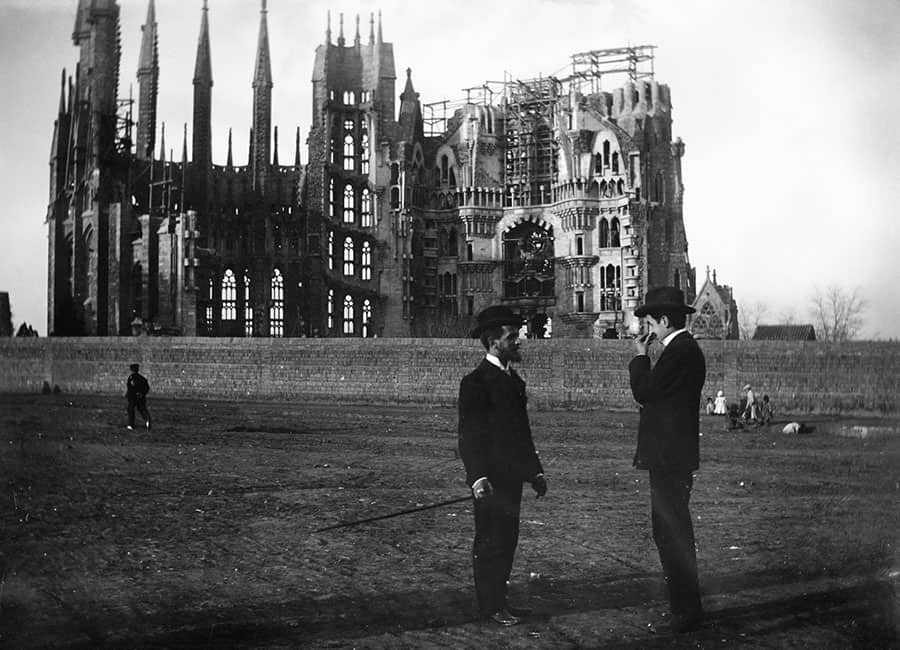
State of La Sagrada, circa 1905….
Taken over by a Captain Ahab-style monomania, Gaudi even moved his studio into the crypt of La Sagrada Familia in 1925 so that he could devote every waking moment to executing his plans. The one-time dandy allowed his appearance and clothes to deteriorate and he became yet more isolated from society.
Gaudi was eventually taken to a hospital for the proletariat… They wanted to move him but Gaudi refused, insisting that: “I belong here amongst the poor.” He died three days after being hit by the tram.
When the architect was hit by a tram in 1926 he was so ragged and conspicuously poor, that nobody recognised him and no cab driver would take him to a hospital (the uncharitable offenders were later fined by the police). Gaudi was eventually taken to a hospital for the proletariat, where he wasn’t recognised until his friends found him there the following day. They wanted to move him but Gaudi refused, insisting that: “I belong here amongst the poor.” He died three days after being hit by the tram.
Despite shunning publicity Gaudi’s popularity and fame had exploded by that time, as many people began to acknowledge the unique genius of his work. Half of Barcelona dressed in black to honour his death, and his body was, fittingly enough, interred in the crypt of La Sagrada Familia.
Which Gaudi works are UNESCO-listed?

They are: Park Guell, Palau Guell, Casa Mila, Casa Vicens, the Nativity façade and crypt of La Sagrada Familia, Casa Batllo and the crypt in Colonia Guell.
The 12 Gaudi Buildings in Barcelona
Although Gaudi’s work was far from unanimously praised at the time (fellow Barcelona-based genii Pablo Picasso and George Orwell were both rather unkind in their opinions!), the young Antoni had no difficulty finding projects to work on during his career, and as such Barcelona is rife with his handiwork.
Here is a list of ALL 12 of the architect’s Barcelona buildings, starting with what we believe are the most breathtaking and unmissable attractions first.
Best Tourist Cards for Gaudi
Savvy travellers can save time and money by investing in the Barcelona Pass, or else the Go City All-Inclusive Pass. Check out our full length article on the best Barcelona tourist cards, where we also offer you a discount on certain passes.
| Included in price? | Barcelona Card | Barcelona Pass | Go City All-Inclusive |
|---|---|---|---|
| La Sagrada Familia | No | YES | YES (+tour) |
| Park Guell | No | YES | YES (+tour) |
| Tourist Bus | 10% off | YES* | YES |
| Casa Mila | €3 off | YES* | YES |
| Casa Batllo | €3 off | YES* | YES |
| Casa Vicens | 25% off | 10% off | YES |
| Palau Guell | 25% off | 10% off | YES (+tour) |
| Price | €55 (72 hrs) | €85 | €159 (2-day) |
| MORE: | BUY CARD | BUY PASS | BUY PASS |
*The Barcelona Pass offers you free entry to ONE of the Tourist Bus or the Casa Mila (or the Casa Batllo for a €10 supplement).
A Good Option: While the city’s official Barcelona Card is not very useful for Gaudi admirers, it includes free public transport and loads of museum entries. Tiqets.com offers a cool Barcelona Card + Gaudi Bundle, which suits the needs of most first-time visitors.
Later in the article, we mention some more places where his handiwork and design elements turn up in the Catalan capital, as well as some of his constructions in Catalonia, Spain and abroad.
1. La Sagrada Familia
The brainchild of a humble bookseller, Josep Maria Bocabella, construction on La Sagrada Familia begun in 1882, funded by public donations, with architect Francisco de Paula del Villar at the helm. When Villar resigned from the project in 1883, a still young (31 years old) Antoni Gaudi took over the project and imprinted his own bold vision on the church. Fusing art nouveau and Gothic styles with a rich abundance of natural motifs, he created a new style of architecture that critics lambasted as grotesque and over the top, but which has stood the iron test of time, fascinating generations ever since. Every façade offers an intricate canvass of reliefs and sculptures paying homage to God and the world he created, while the proliferation of honey-combed towers reaches impossibly high into the sky. The unfinished central spire will reach a whopping 170 metres when completed, just one metre lower than Barcelona’s coastal mountain Montjuic, for – as Gaudi famously retorted – “man should not exceed God”. Impressive though the exterior is, it’s just half the story. The interior is as elegant and refined as the exterior gaudy and grandiose, with Tolkien-esque white tree-like columns climbing up to the hypnotising geometry of the nave’s roof, while kaleidoscopic light filters in from the delicate stained glass windows. The sheer beauty of it borders on the impossible. No surprise that’s it by far Barcelona’s most visited attraction, and ticket prices are what fund its ongoing construction.
LA SAGRADA FAMILIA FACTS
Constructed: 1882 til present day
Commissioned by: Josep Maria Bocabella
UNESCO-listed: Yes
Our Verdict: 11/10 – You have to see it to believe it!
Must Visit?
SKIP-THE-LINE TICKETS
You can buy fast track tickets via Get Your Guide for €33.80, with audio guide. If you can afford it, I suggest upgrading your ticket to include tower access (your choice of Passion or Nativity… the experience is essentially the same).
RECOMMENDED GUIDED TOURS
For me, the best tour is the Sagrada Familia with Towers guided tour (€65). Otherwise, browse more options on Get Your Guide.
BARCELONA PASS
If Gaudi is a key part of your itinerary, I suggest purchasing a Barcelona Pass via Tiqets.com. With one convenient purchase you can access La Sagrada Familia, Park Guell and the Hop on / Hop off Tourist Bus. Price €86.50.
2. Park Guell
When the industrialist Eusebi Guell wanted to build a garden city for Barcelona’s aristocracy, he tasked Gaudi with landscaping a park that would help him sell the project’s luxury country villas. In the end only two houses were built, and only one sold – to none other than Gaudi himself, who lived in what is now the Gaudi House Museum (more info below) between 1906 to 1926. As a real estate project Park Guell was a failure, but as a city icon and tourist attraction it has proven a runaway success. Visitors start by walking through the grand reptilian-esque pavilions at the gates, before greeting the famous brightly-coloured lizard sculpture on the stairs (stopping for the obligatory selfie), and then wending their way through columns and sculpted earth up to the splendid open terrace where they can sit on undulating benches, decorated with broken-tile mosaics, and enjoy views over the entire Barcelona out to the Mediterranean sea.
PARK GUELL FACTS
Constructed: 1900-1914
Commissioned by: Eusebi Guell
UNESCO-listed: Yes
Our Verdict: 10/10 – Gorgeous park with breathtaking views
Must Visit?
RECOMMENDED GUIDED TOURS
Enjoy the added insight of a licensed tour guide on this 1.5 hour Walking Tour. Alternatively, hop on an Electric Bike and see not only Park Guell, but most of the buildings on this list with Gaudi Bike Tours.
BARCELONA PASS
Along with La Sagrada Familia, Park Guell is included in the Barcelona Pass available on Tiqets.com. Price €86.50.
3. Casa Mila (La Pedrera)
Passeig de Gracia, atop of Las Ramblas, is the showcase street of Modernisme in Barcelona and of course the great man himself left his mark, designing both the Casa Batllo and the Casa Mila. The latter, also known by its nickname La Pedrera (The Quarry), was the last great work Gaudi finished before dedicating himself entirely to La Sagrada Familia basilica. Sinuous curves, elaborate metalwork and spiralling, mosaic-tiled, chimneys represent arguably the architect’s most accomplished expression of the unique style he created. Visitor tickets include access to the impressive Flower and Butterfly Courtyards, The Tennants Aparment – where you can see a preserved apartment, from 100 years ago, The Whale Attic – home of an exhibition on the architect, and access to the rooftop with its ‘Warrior’ chimneys and views over the Passeig de Gracia.
CASA MILA FACTS
Constructed: 1906-1912
Commissioned by: Pere Mila
UNESCO-listed: Yes
Our Verdict: 9/10 – Biomorphic mansion with one-of-a-kind façade
Must Visit?
SKIP-THE-LINE TICKETS
Skip-the-line tickets with audioguide cost €25, or upgrade your ticket to included ‘Mixed Reality Glasses’. Available via Get Your Guide.
NIGHT TOURS
To see Casa Mila in a different light, reserve La Pedrera: Night Experience. Ticket includes guided nocturnal tour and audiovisual show on the rooftop.
4. Casa Batllo
Another of the Modernista masterpieces on the sweeping Passeig de Gracia boulevard (not all of them, were created by Gaudi… read up on Barcelona’s other top architects such as Puig y Cadafalch), the Casa Batllo was built in 1877 and remodelled by Gaudi between 1904 to 1906 for the aristocrat Josep Batllo. Fans of fantasy will love the dragon-crest roof, the bright coral-coloured façade, the shark-skull balconies and the skeletal carapacing on the lower floors. The last two features helped earned the building the nickname “The House of Bones”. Those that visit the interior will also see the magnificent Entrance Hall, Noble Floor, Patio of Lights, Indoor Garden, Loft and Roof Terrace. Additionally, some tickets options (see below) offer you access to the Gaudi Dome and Lord Batllo’s bedroom.
CASA BATLLO FACTS
Constructed: 1904-1906
Commissioned by: Josep Batllo
UNESCO-listed: Yes
VERDICT: 9/10 – An unmissable flight of fantasy
Must Visit?
SKIP-THE-LINE TICKETS
Standard ‘Blue’ tickets (€35) include audio guide, Silver tickets (€43) include access to the immersive Gaudi Dome, and Gold tickets (€45) also include the chance to peak inside Lord Batllo’s bed chambers. All are available on Get Your Guide.
NIGHT EXPERIENCE
During the warmer months, Casa Batllo hosts concerts on its dragon-ridged rooftop. These Magic Nights include nocturnal tour, followed by music with Cava.
Take The Gaudi Quiz!
5. Casa Vicens
Commissioned in 1978 and built between 1883 and 1885, Casa Vicens was Gaudi’s first major work to be finished. A private house designed for the industrialist Vicens, this Moorish-influenced marvel was only opened up to the public in late 2017 and has not yet reached the popularity of the architect’s mansions on the Passeig de Gracia. For sheer colourful beauty it’s hard to beat, with a mix of Art Nouveau and oriental ceramics and brickwork providing an onslaught of vivid hues inside and out. There’s a beautiful rooftop terrace to chill on and a live guide on each floor to answer your questions.
CASA VICENS FACTS
Constructed: 1883-1885
Commissioned by: Manuel Vicens i Montaner
UNESCO-listed:Yes
VERDICT: 8/10 – Newly-opened mansion with Moorish touches
Must Visit?
SKIP-THE-LINE TICKETS
You can buy skip-the-line tickets via Get Your Guide. At just €18 it’s a fair bit cheaper than the other Gaudi casas.
6. Palau Guell
This sumptuous palace was created as the Guell’s family residence, on the Nou de la Rambla. The impressive parabolic arches at street level were built to allow the family to arrive via horse and carriage, while the lavish, intimidating interior offers a tantalising insight into late 19th / early 20th century aristocratic life. The exterior’s rather austere grey and white stonework is offset by the rooftop’s surreal chimneys of fantastic colours (Gaudi’s trademark!), and a central spire topped off by a bat-winged monster. Look out for the Catalan coat of arms on the entrance.
PALAU GUELL FACTS
Constructed: 1886-1888
Commissioned by: Eusebi Guell
UNESCO-listed: Yes
VERDICT: 8/10 – Intriguing and underrated palace.
Must Visit?
7. Torre Bellesguard
Bellesguard means “beautiful view” in Catalan, meaning you’re treated to both splendid architecture and vistas, when you make the journey up to this edifice. One of Gaudi’s only buildings to incorporate straight lines (he famously favoured curved forms, arguing that straight lines appear nowhere in nature), it’s maybe not his most iconic edifice, but its full of his trademark fantasy and art nouveau motifs. Best of all, its relatively crowd-free.
TORRE BELLESGUARD FACTS
Constructed: 1900-1909
Commissioned by: Jaume Figueres
UNESCO-listed: No
VERDICT: 8/10 – Medieval castle meets Art Nouveau
Must Visit?
SKIP-THE-LINE TICKETS
You can buy fast track tickets to Torre Bellesguard via Get Your Guide. Price €9.
8. Casa Calvet
One of Gaudi’s earliest works, the Casa Calvet is barely known to locals, let alone tourists. You might think that would make it a dud, but it was avant garde enough at the time of its completion to win Building of the Year in 1900. You can’t enter the building sadly, but it is centrally located, so you may well want to pass by and admire the façade with its attractive masonry and curved wrought-iron balconies. Photo from Wikimedia.
CASA CALVET FACTS
Constructed: 1899-1900
Commissioned by: Pere Calvet
UNESCO-listed: No
Verdict: 6/10 – Town house with Modernista motifs
Accessibility: Not open to the public, but take a look if you’re passing by!
Best Tour Option: Private Gaudi Bike Tour.
9. College of the Teresians
Another of Gaudi’s early works, Antoni took over this project – the design of a female boarding school – from another architect, completing the work on a budget as befitting a religious order bound by a vow of poverty. Still a school today, you can’t enter, but the impressive red brick facade is worth a gander if you’re in the neighbourhood, even if it’s a far cry from Gaudi’s signature work.
COLLEGE OF THE TERESIANS FACTS
Constructed: 1888-1890
Commissioned by: Father Enric Osso
UNESCO-listed: No
Verdict: 7/10 – Gaudi does Gothic for girls’ college
Accessibility: Not open to the public, but lovely exterior.
10. Guell Pavilions
The Pavellons Guell were built between 1884-87 and were Gaudi’s first commission for Eusebi Guell, who would continue to patron the architect throughout his career. In this case “pavilion” means gatehouse, and Gaudi built two of them in striking yellow and terracotta brick, one serving as a stable, the other as a gatekeeper’s lodge. Between them is an elaborate wrought-iron gate that depicts the myth of the Garden of the Hesperides, complete with dragon, mouth agape. The site now belongs to the Polytechnic University of Catalonia, so you can’t venture beyond the gate. But you can at least admire the structures from outside. More info here.
GUELL PAVILIONS FACTS
Constructed: 1884-1887
Commissioned by: Eusebi Guell
UNESCO-listed: No
Verdict: 7/10 – Striking gatehouses out in Pedralbes
Accessibility: Visible from the outside only.
11. Sagrada Familia School
This humble building was originally built as a small school for the children of the workers building the Sagrada Familia. It’s undulating form combines elegance and strength and has been much imitated in the architectural world, by no less than Le Corbusier and Calatrava for starters. It’s likely Enric Miralles had this school in mind when he designed the roof of Barcelona’s Santa Caterina Market as well. In 2002 the school was dismantled and rebuilt right at the foot of La Sagrada Familia, and you can visit it when you buy a ticket for the church. Photo by Wikimedia.
SAGRADA FAMILIA SCHOOL FACTS
Constructed: 1908-1909
Commissioned by: Josep Maria Bocabella
UNESCO-listed: No
Verdict: 6/10 – Funky school house with reptilian roof
Accessibility: Now part of La Sagrada Familia.
12. Crypt at Colonia Guell
Just outside the Barcelona city limits, you will need to catch a train to see this stunning work of architecture, but if time is on your side it’s well worth the relatively minor hassle of moseying on over. Colonia Guell was an industrial park built by Gaudi’s major patron, Eusebi Guell, for a textile factory he owned. The Colony was built to house the workers, and featured a theatre, school, convent and inn, amongst other structures. Gaudi was to design the church, but only the crypt got made before financial losses meant the project had to be pulled. Still, it is a stunning work of architecture on which Gaudi practiced pioneering architectural techniques that he would later use on La Sagrada Familia. The rest of the Colony is also designed in the Modernista style.
CRYPT AT COLONIA GUELL FACTS
Constructed: 1908-1914
Commissioned by: Eusebi Guell
UNESCO-listed: Yes
Verdict: 7/10 – Gorgeous crypt in time-trapped textile colony
SKIP-THE-LINE TICKETS
You can reserve your Colonia Guell crypt tickets via Get Your Guide. Price €10.
More Gaudi Works in Barcelona
The remainder of this list constitutes works or features designed by Gaudi, rather than entire buildings. Some are central and very easy to find when you’re wandering around town.
13. La Cascada Fountain
This epic Roman-style fountain, topped with an ostentatious statue of a golden goddess riding a four-horse chariot, was designed by Josep Fontsere and is distinctly more gaudy than Gaudi. The Modernist man did contribute to its design though whilst still a student, designing its water tank and hydraulics, as well as several stone medallions with reptilian reliefs. Catch it in the central Parc de la Ciutadella. Most of Barcelona’s best bike tours pass by the fountain, so signing up for a cycle is a great way to see it.
14. Street Lamps (Pl. Reial and Pla de Palau)
Upon finishing the work on the Cascada Fountain, the city council commissioned Gaudi to design the lampposts for Plaça Reial (Royal Square), which were installed in 1879. He set out his artistic stall with an elaborate six arm structure, with each lantern topped by a dragon, and the central post crowned by a winged helmet. Plaça Reial is one of Barcelona’s most beautiful corners in the Gothic Quarter, and a central nightlife hub, so be sure to pass by night or day (depending on your preference!). You can find a more modest version of the same design on the nearby Pla de Palau square.
15. Street Tiles (Psg. de Gracia)
Few people know it, but the very streets tiles of the Passeig de Gracia (the magnificent boulevard that is home to both the Casa Mila and the Casa Batllo) were designed by Gaudi. The architect created the hexagonal starfish and sea snail decorated panots in 1904, with the city council first using them to pave the street in 1971. You can read more about their history and here.
16. Finca Miralles Gate
With its undulating form and reptilian-like ‘skin’, there’s no mistaking the architect of this threshold, which once marked the entrance to the Miralles family estate. The estate has since been destroyed, but the gate remains perfectly intact and you can visit it in the Sarria district of Barcelona. Under the gate stands a life-size statue of Gaudi by the sculptor Joaquim Camps. You can find more info on the gate here. (Photo by Francois Philipp).
The Gaudi Museums
As well as by visiting his buildings themselves, you can learn more about Gaudi at various museums around the city.
1. Gaudi House Museum
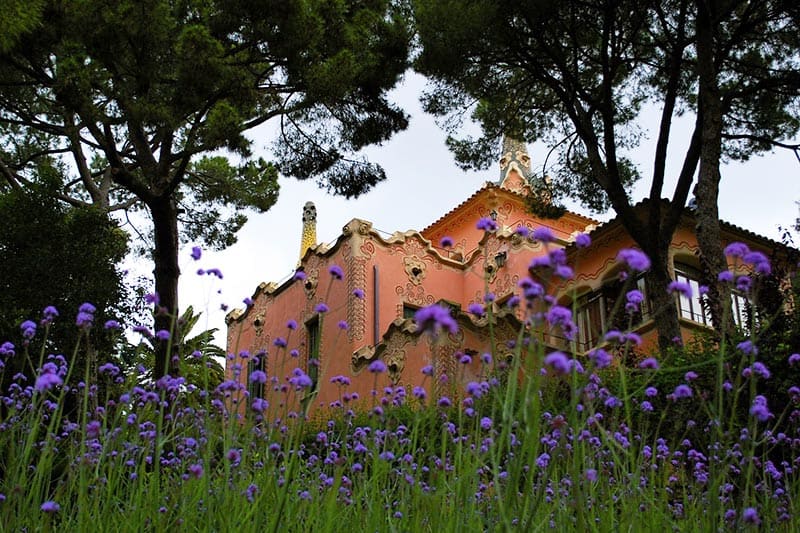
2. Gaudi Experience
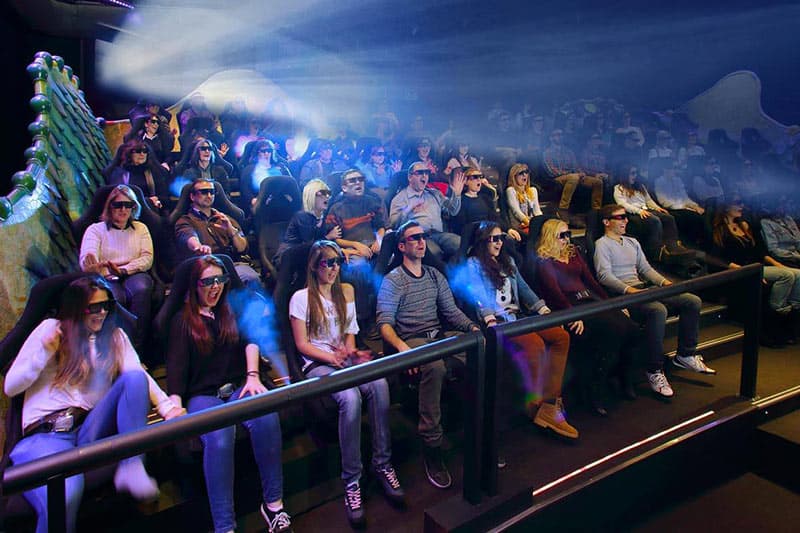
3. National Museum of Catalan Art (MNAC)
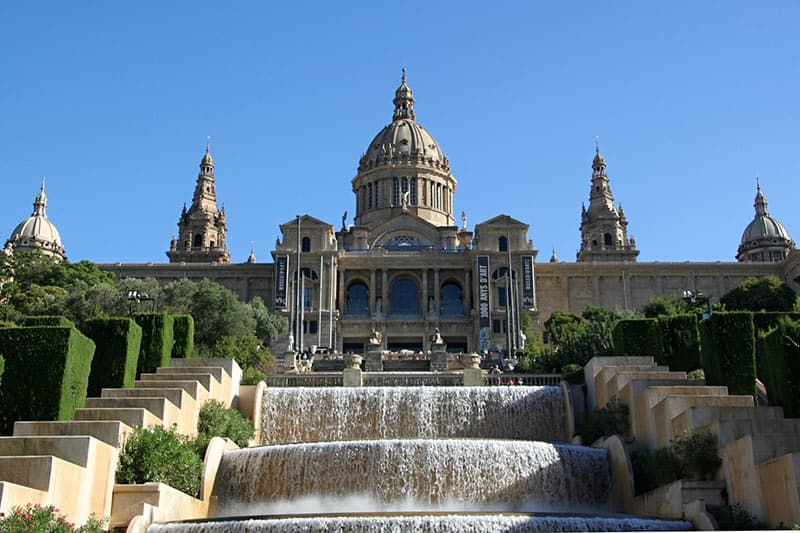
Top 4 Gaudi Tours
And if you’re keen to experience the genius of Gaudi illuminated by a knowledgeable guide, then just hold your breath a little while we rummage around for some amazing Gaudi tours for you to experience… et voila:
1. World of Gaudi: Sagrada Familia, Park Guell & Casa Batllo
My advice to any first-time visitor to Barcelona interested in Gaudi, would be: try to see La Sagrada, Park Guell and one of the mansions, and this ‘World of Gaudi’ tour delivers exactly that. You start on the magnificent Passeig de Gracia boulevard, where your knowledgeable guide will guide you through the magical Casa Batllo, before private transport whisks you up to Park Guell to see the famous trencadis lizard and viewing terrace. The final stop is La Sagrada Familia, where you not only get a guided tour of the interior but also a thorough look around its fascinating exterior. The tour is currently rated 4.9/5 on Get Your Guide, and is reasonably priced at €169 per person.
2. Gaudi Bike Tours
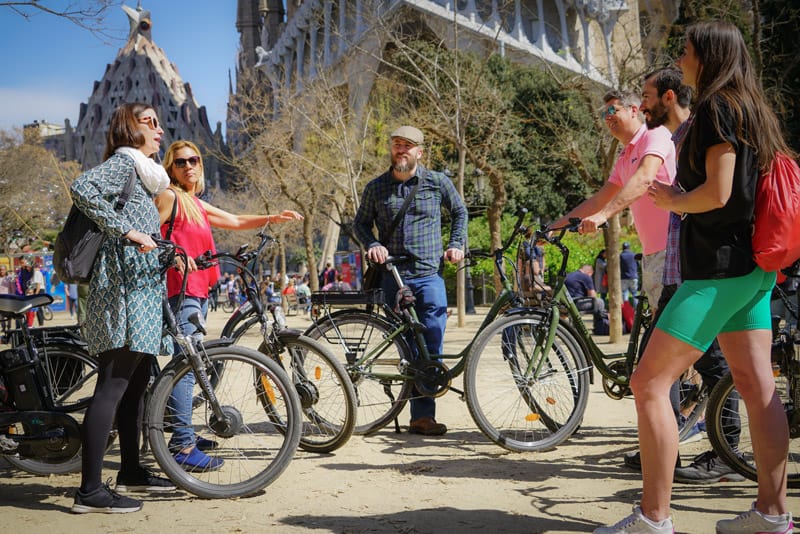
www.gaudibiketours.com
3. Private Gaudi & Barcelona Highlights Tour
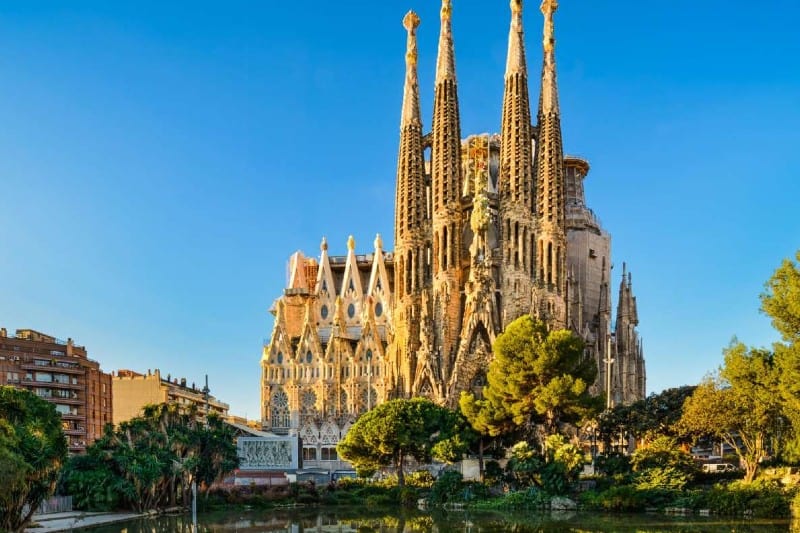
4. Gaudí, Sagrada Familia & Modernism Free walking Tour
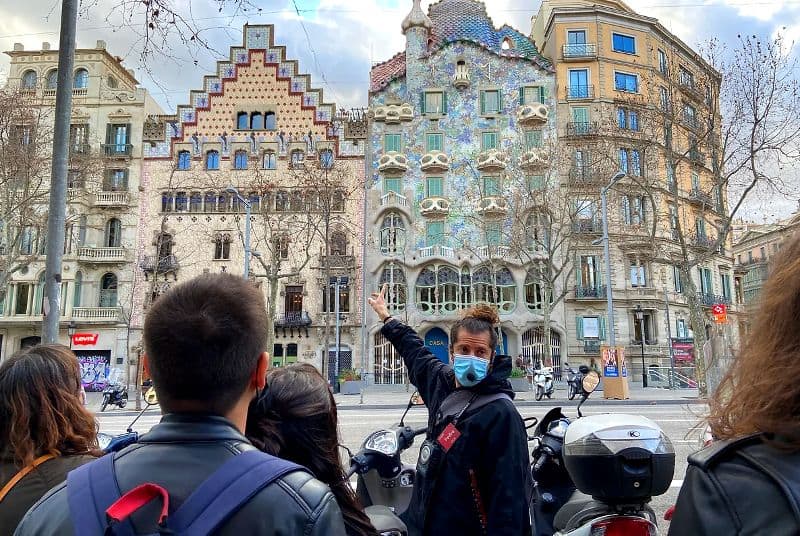
The Gaudi Map
Below you can find all of Gaudi’s architecture, design and museums in Barcelona. Purple pins represent his 12 buildings, blue pins his other design work, and red pins museums or exhibitions dedicated to Gaudi.
Other Art Nouveau in Barcelona
Gaudi was both part of, and separate to, the prevalent Modernista movement of the time. In fact he was born just one year after Domenech i Montaner, who was the leading protagonist of the movement and one of young Antoni’s teachers. Gaudi of course went his own way, but undoubtedly he was massively influenced by what was going on all around him as the city developed at a rapid pace, fuelled by the wealth of the industrial revolution.
What’s our point? It’s that, when in BCN, don’t be so obsessed with one man’s work that you miss a whole host of amazing architecture by his peers that is sure to enthral those who pay enough attention. For example, be certain to at least wonder past the wonderful Palace of Catalan Music designed by Domenech i Montaner, if not see a concert, and do as well pop your head in the legendary “Four Cats” cafe, one of the centres of intellectual thinking – and drinking – at the time.
Gaudi in Catalonia
The following works can be found close to Barcelona…
Bodegas Guell
Another project commissioned by Eusebi Guell, this winery was designed for the Count’s country estate out on the Garraf massif, about 25km outside Barcelona. The complex consists of the wine cellars themselves, a house and chapel, all in one building, whilst several hunting pavilions were designed but never built. Although the construction was carried out by Gaudi’s right hand man, Francesc Berenguer, there’s no mistaking the architect’s vision amongst the building’s parabolic arches and fairytale gables. Until recently the former bodega functioned as a restaurant, but that’s been closed for a while… we heard a whisper that the site might be open for visitors soon. For now you can read more here.
La Nau Gaudi
La Nau Gaudi is an exhibition space in the coastal town of Mataro, housed in the remains of an industrial complex that Gaudi worked on between 1878 and 1883, after he had just finished university. The owner of the textile cooperative was a pal of Antoni’s from his hometown of Reus, and the architect designed a bleaching house, some new latrines, and a new company banner, as well as two casinos that never got built. The bleaching house is in fact the first ever structure our Antoni completed, and – whilst I wouldn’t advocate a special journey – if you are ever in Mataro it’s worth calling by to admire this artfully simple shed, and the rotating art exhibitions it hosts. Admission free. Worth noting is that while working on this project Gaudi fell in love with a girl from this town called Pepita Moreu. Her rejection of his marriage proposal hit him hard, and perhaps goes some way to explaining why he never married, dedicating his life to his work and to God.
naugaudi.cat
Xalet Catllaràs
I’ll give you three guesses who commissioned this chalet…. that’s right, it was the rich-as-Croesus Eusebi Guell. The cash-splashing Count had another of his factories and some mines up here in the Sierra de Catllaràs and asked Antoni to dream him up a little alpine abode for his engineers. It’s a cute little number and currently being renovated for spring 2019 according to La Vanguardia. We’re confident they’ll be well behind schedule. Sadly it’s too far to be easily accessible from Barcelona, but for residents heading to the Pyrenees for a spot of skiing, this would make a fun spot to call in on.
Artigas Gardens
While he was up in the Pyrenees designing the chalet above, Gaudi discovered he had a fan in the form of Joan Artigas Alart. This wealthy textile industrialist admired the architect’s plans for Park Guell and commissioned him to do something similar to his own patch of land in the Pyrenees. Taking advantage of the beauty of the mountain springs, Gaudí constructed a garden that enables the visitor to enjoy the rushing water via various lookouts, bridges and balustrades.
More Info
If you’re still thirsty for more knowledge on Antoni then check out these excellent websites:
Gaudi Club
Gaudi’s Buildings on UNESCO
Antoni Gaudi Biography on Wikipedia
About the Author
Duncan established Barcelona Life in 2009, whilst freelancing for the likes of Conde Nast, The Guardian, Easyjet Magazine, CNN Traveller and many more. From interviews with Ferran Adria to revealing the secrets of the city’s poetry brothels, he knows the city inside out… and shares all his best tips right here.


